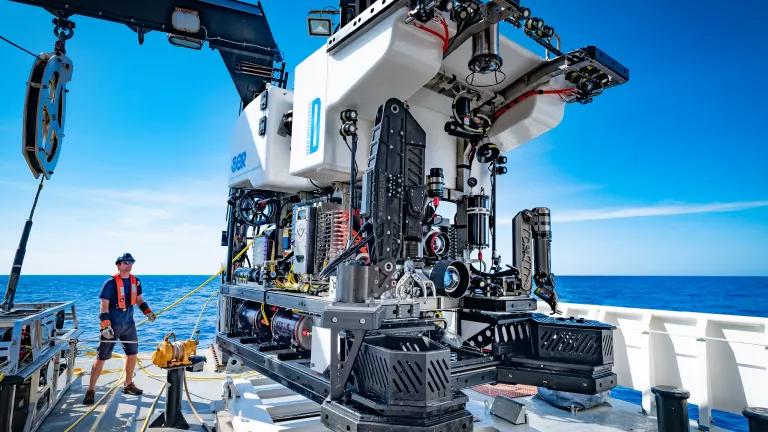An Ocean of Risks: The Case for an Ocean CDR Code of Conduct
An ocean research code of conduct is essential to ensure that unintended consequences of this research field don’t end up doing more harm than good.

BondiBeach2026, CC BY-SA 4.0, via Wikimedia Commons
Carbon dioxide removal (CDR), or carbon drawdown, is a process in which CO2 is removed from the atmosphere and sequestered for a period of time. In the arsenal of tools to battle climate change, CDR has traditionally focused on land-based techniques—reducing atmospheric CO2 through natural removal by restoring forests and soils, or via technological means such as direct air capture and sequestration But oceans cover 70% of the Earth’s surface and they draw CO2 from the atmosphere through natural processes—so interest is now skyrocketing among policymakers, funders, scientists, and entrepreneurs to research how the oceans’ natural CO2 removal processes may be accelerated, enhanced, or augmented with a wide range of potential approaches.
This nascent field, however, has virtually no regulatory—or even voluntary—guardrails aimed at ensuring the safety and efficacy of its research. A large number of ocean CDR strategies are being explored, and all present the risk of uncertain environmental and social impacts. Some involve manipulations of ocean chemistry or biology, representing a form of climate engineering. The field of ocean CDR urgently needs a code of conduct that establishes principles of responsible research, fairness, and equity.
Last year, the National Academies of Sciences, Engineering, and Medicine came together to develop a research plan for ocean CDR. Their December 2021 report calls for a $125 million research program over the next decade to better understand the overarching challenges of ocean-based CO2 removal approaches, including potential economic and social impacts. It also recommends the development of a research code of conduct.
The NAS examined several of the leading (so far) ocean CDR strategies, including:
- Ocean nutrient fertilization. Adding macronutrients such as iron, phosphorus, or nitrogen to surface ocean waters—somewhat akin to fertilizing crops on land—can speed growth of marine phytoplankton which absorb CO2.
- Artificial upwelling/downwelling. With the similar goal of increasing phytoplankton production in surface waters, artificial upwelling uses pipes and pumps to bring up deep, cold, nutrient-rich water to the surface. Artificial downwelling could be a means to carry carbon into the deep ocean.
- Enhancing ocean alkalinity. Seawater chemistry can be altered to raise pH levels through methods such as enhanced mineral weathering and thermal or electrochemical (electrolysis) reactions.
- Large-scale kelp/seaweed farming. Growing large amounts of seaweed near shorelines can absorb CO2 from the atmosphere through photosynthesis, then be transported into the deep sea or into sediments where the carbon can be sequestered.
These approaches and many others vary widely in their current knowledge base, viability, efficacy, sequestration durability, carbon accounting challenges, and cost. But all have potential ecosystem damage “side effects.” These could include phytoplankton or cultivated macroalgae robbing nutrients from natural plankton and algae nearby; toxic effects on marine life from the release of trace metals in the alkalinity enhancement process; and the potential alteration of weather patterns, local ocean currents, and/or larger-scale ocean circulation patterns. And virtually no ocean CDR approaches have a formal research code of conduct for how they will be pursued or implemented. Four research colleagues and I recently published a paper in the journal Frontiers in Marine Science calling for such a code of conduct as a safety net for ocean CDR research.
Jurisdiction over the ocean varies widely. Nations or subnations (states or provinces) regulate areas within 200 miles of shore, while the high seas do not fall under any single government jurisdiction. The result is a complicated and incomplete patchwork of regulation over ocean activities. Both domestic and international regulation on ocean CDR research and development is alarmingly lacking. Some ocean CDR research activities may fall under existing regulatory schemes, such as pollutants emission or impacts to protected species, but these regulations have not yet been applied to CDR.
Good code of conduct models exist in other research fields that also have implications for human or environmental welfare, such as nanotechnology, gene editing, and geo-engineering. Common principles in these codes require researchers to assess and minimize potential environmental harms before and throughout experiments. A tiered research structure requires researchers to demonstrate the potential efficacy of a technology—via lab work, modeling, or in small field trials—before scaling up to larger in situ experiments. The principles promote public and stakeholder engagement, consider fairness and equity, and require the overall need to involve the global community in decisions about climate engineering.
Perhaps the fastest route for the field to adopt such a code of conduct is for funders of ocean CDR research, both private and public, to make their grants and other funding mechanisms contingent upon adherence to code principles. But regardless of how we get there, it is time for ocean CDR researchers to create, adopt, and follow a research code of conduct. It’s an essential tool to ensure that unintended consequences of this research field don’t end up doing more harm than good.




